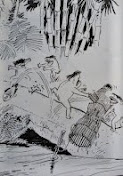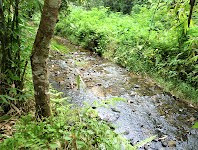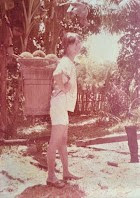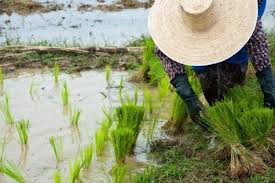My grandmother's maiden name was Lotimboi Binte Gumpai. She was a petite woman, typical of the small-frame rural Dusun women of her time. It is believed that she married my grandfather in 1927, when she was just 14 years old. By then, my grandfather was already in his mid-forties. Such early marriage was quite common among indigenous communities in those days!
 |
| 13.8.1913 - 28.1.1981 |
After the marriage, my grandparents settled in a traditional bamboo house in Kampong Pulutan, Menggatal. My grandmother had two children with my grandfather - my mother, who was born a year after marriage in 1928, and my uncle, born two years later.
In 1950 when she was 37, her husband (my grandfather) passed away at the age of 68. Unlike many Kadazan women of her time who remarried after losing their spouses, she chose to remain a widow, living alone for the next 31 years. She passed away in 1981, also at the age of 68, in the same village where she had spent her entire married life.
Though married to a Chinese, my grandmother remained, in many ways, a quintessential rural Dusun woman. She preferred walking barefoot in the fields, chewed betel nut, and smoked traditional leaf-wrapped cigars. She became fluent in Hakka and learned to cook a variety of Hakka dishes, blending the two cultures in her daily life with quiet grace.
These are photos of my grandmother at her younger days. Although she was Dusun, I never once saw her dressed in Dusun attire - instead, she always wore the classic Chinese blouse, a reflection of the cultural blend in her life.
I vividly remember her sitting among her grandchildren, calmly puffing on her homemade cigar. For some of us, the strong, earthy smell was almost unbearable. She once explained that one reason she smoked was to keep the mosquitos at bay while working in the fields and orchard - a practical habit rooted in her daily life.
 |
| Ingredients & tools for betel chewing. |
My grandmother was a remarkable enterprising woman. On her modest plot of land, she cultivated a variety of fruit trees - durian, rambutan, langsat, tarap, and bambangan. During the fruiting season, she would harvest some of the produce from her orchard and bring it to the local tamu (market) in Menggatal to sell.
At times, to maximize her profits, she took it a step further. She would buy durians from neighbouring orchard owners, pack them in two large baskets suspended on a long wooden pole, and take a bus to Jesselton (later renamed Kota Kinabalau following the formation of Malaysia). From the bus stop, she would carry the heavy load by foot to the market, where the fruits could fetch significantly higher price than in Menggatal.
During the off-season, when fruit was scare, she tapped rubber to help support the family. Her determination to market local produce never waned - not even after her two children had grown up, married and started families of their own. Her industrious spirit was unwavering and deeply inspiring.
When my then girl friend first visited KK back in 1978, she was taken to the tamu in Menggatal - the very market where my grandmother used to sell her produce. In the photo, my GF is seen at the left. Remarkably, the tamu hasn't changed much by then; it still retained the rustic charm of earlier days!
Every two months or so, she would visit our house on Harrington Road (renamed Jalan Istana) to spend an afternoon with her daughter and grandchildren. Her visits were always a delight for us children, as she never came empty-handed - bringing along fruits, and treats that we eagerly looked forward to.
One vivid memory that has stayed with me is how her presence seemed to linger for days even after she left. This was partly due to the red stains scattered around the compound - marks left behind by her betel nut chewing. For fun, we grandchildren would sometimes chewed betel ourselves, competing to see whose spits turned out the reddest!
Looking back, my grandmother left a quiet yet enduring impression on me. She was a gentle and patient soul who rarely expressed her inner thought aloud. In all the times we spent together, I never once saw her raised her voice in anger or lift a hand against us - even when we misbehaved.
Sometimes, I still missed her. I wished I had taken the time to know her better.
Bambangan
Langsat
Tarap
P.S. The indigenous people living north of Kota Kinabalu - in areas such as Inanam, Menggatal, Kiulu - typically identified themselves as Dusuns. Traditionally, the Dusuns settle close to the jungle fringes. In contrast, the Kadazans were predominantly found in regions like Penampang and Tambunan. Following the formation of Malaysia, the term KadazanDusun was introduced as a unifying identity to represent both the Dusun and Kadazan communities.













































